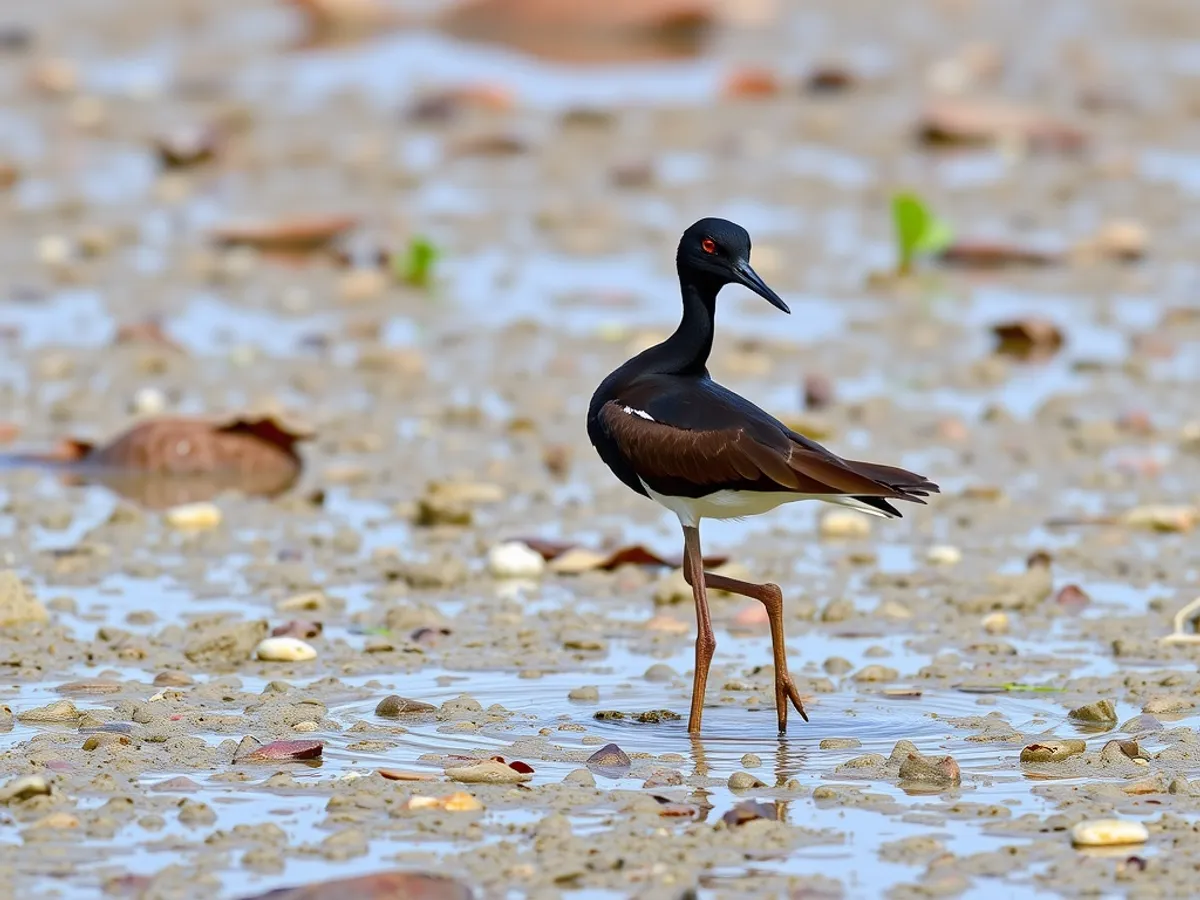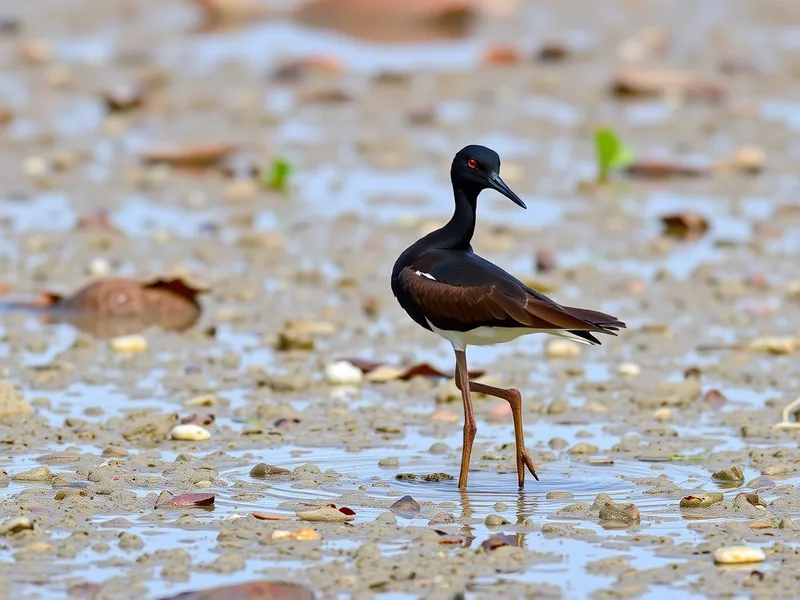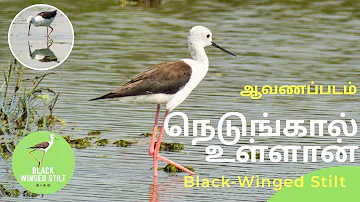
Black-necked Stilt
Himantopus mexicanus

Meet the Black-necked Stilt
The Black-necked Stilt is a striking wader known for its long, slender pink legs and contrasting black-and-white plumage. This bird is commonly found in shallow wetlands, marshes, and mudflats across the Americas, where it forages for aquatic invertebrates and small fish. Its thin, straight bill is perfectly adapted for probing the mud in search of prey. The Black-necked Stilt is notable for its loud, sharp calls and highly territorial behavior during the breeding season.
Classification
Bird
Habitat
Shallow wetlands, marshes, mudflats, and ponds
Diet
Carnivore
Lifespan
5-10 years
Conservation
Least Concern
Weight
140-200 grams
📖Fascinating Facts
Stilted Legs
Their legs are so long that they often appear awkward while walking, but these help them wade into deeper waters than most other shorebirds.
Nest Defenders
Black-necked Stilts use broken-wing acts and loud calls to draw predators away from their camouflaged nests.
Wide Range
They are found from the United States through Central America and into South America, adapting to a variety of wetland habitats.
📋Detailed Description
The Black-necked Stilt (Himantopus mexicanus) is a medium-sized wader, measuring 33–38 cm (13–15 in) in length with a wingspan of 71–76 cm (28–30 in). It is instantly recognizable by its extremely long, slender pink legs—among the longest in proportion to body size of any bird—and its contrasting plumage: glossy black on the back, wings, and nape, with a white face, underparts, and tail. The bill is straight, thin, and black, measuring about 6–9 cm (2.4–3.5 in), perfectly adapted for probing mud and shallow water. Sexual dimorphism is subtle; males typically have a greenish or bluish sheen on the black areas, while females may appear browner. Juveniles display a more mottled brown-black coloration. The species is highly vocal, producing a sharp 'kek-kek-kek' alarm call, especially during the breeding season. Black-necked Stilts are agile fliers and strong swimmers, though they rarely dive. Their long legs allow them to wade into deeper waters than many other shorebirds, expanding their foraging niche. They are often seen in small, loose flocks outside the breeding season, but become fiercely territorial when nesting. Their striking appearance and conspicuous behavior make them a familiar sight in wetlands across their range.
💡 Did you know?
Despite their delicate appearance, Black-necked Stilts are fiercely protective parents and will aggressively defend their nests against much larger intruders.
🔬Research & Sources
Wikipedia Summary
The black-necked stilt is a locally abundant shorebird of North and South American wetlands and coastlines. It is found from the coastal areas of California through much of the interior western United States and along the Gulf of Mexico as far east as Florida, then south through Central America and the Caribbean to Brazil, Peru and the Galápagos Islands, with an isolated population, the Hawaiian stilt, in Hawaii. The northernmost populations, particularly those from inland, are migratory, wintering from the extreme south of the United States to southern Mexico, rarely as far south as Costa Rica; on the Baja California peninsula it is only found regularly in winter. Some authorities, including the IUCN, treat it as a synonym of Himantopus himantopus.
Last Modified: 5/25/2025
🎭Behavior & Social Structure
Black-necked Stilts are diurnal and spend much of the day foraging in shallow water, where they use their slender bills to pick or sweep for aquatic invertebrates, small crustaceans, mollusks, and occasionally small fish or tadpoles. They employ a variety of feeding techniques, including pecking at the surface, sweeping their bills side to side, and sometimes even chasing prey in short bursts. Socially, they are gregarious outside the breeding season, forming flocks that may number in the hundreds at rich feeding sites. During the breeding season, pairs become highly territorial, aggressively defending nest sites with aerial displays, loud calls, and distraction behaviors such as the 'broken-wing' act to lure predators away from nests. They are known for cooperative mobbing of predators, sometimes enlisting neighboring pairs. Roosting typically occurs on exposed mudflats or shallow water, often with other wader species.
👶Reproduction & Life Cycle
Black-necked Stilts are monogamous during the breeding season, which varies geographically but generally occurs from March to August in North America. Courtship involves ritualized displays, including mutual preening and synchronized foraging. Nests are simple scrapes on the ground, often lined with grass, pebbles, or shells, and are usually located on open mudflats or islands to minimize predation risk. Clutch size is typically 3–5 pale buff eggs with dark blotches. Both parents share incubation duties, which last 22–26 days. After hatching, the precocial chicks leave the nest within hours and are able to swim and feed themselves, though they remain under parental protection for several weeks. Fledging occurs at about 4–5 weeks. High nest site fidelity is observed, with pairs often returning to the same area in subsequent years.
🛡️Adaptations & Survival
The Black-necked Stilt's exceptionally long legs enable it to forage in deeper water than most shorebirds, reducing competition for food. Its slender, straight bill is specialized for picking small prey from the surface or just below. The contrasting black-and-white plumage may serve as disruptive coloration, confusing predators. Behavioral adaptations include highly aggressive nest defense and distraction displays to protect offspring. The species is also highly mobile, with northern populations exhibiting migratory behavior, moving southward in winter to exploit seasonal wetlands. Their ability to exploit both saline and freshwater habitats increases their ecological flexibility.
🎨Cultural Significance
The Black-necked Stilt is appreciated by birdwatchers for its elegance and striking appearance. In some indigenous cultures of the Americas, stilts are seen as symbols of vigilance and balance, owing to their upright posture and alert behavior. The species is occasionally featured in local folklore and wetland conservation campaigns, serving as a flagship species for wetland protection. There are no significant records of traditional use for food or feathers, but their presence is often considered an indicator of healthy wetland ecosystems.
🔬Recent Research & Discoveries
Recent research has focused on the systematics of the Himantopus genus, with ongoing debate about species limits and the relationship between Black-necked, White-backed, and Hawaiian Stilts. Genetic studies indicate some gene flow between populations, but also support the recognition of distinct forms. Studies on reproductive success have highlighted the importance of water level management in breeding habitats. Ongoing monitoring projects track population trends and migration using banding and satellite telemetry. Research into the impacts of contaminants and climate change on stilt populations is ongoing, with some evidence of reduced reproductive output in polluted wetlands.
🎥Wildlife Videos

🦩 The Black-Necked Stilt – The Elegant Wader with Bold Style! 🌊🔥
The Black-Necked Stilt – The Elegant Wader with Bold Style! Meet the Black-Necked Stilt, a graceful wader with long, slender ...
Ases World

Black winged stilt birds documentary of Bangladesh*****
Black-winged stilt birds documentary of Bangladesh #eleventh# #hour#Blackwinged# #documentary# #satkhira# ...
Eleventh Hour

Black-Winged Stilt - Documentary - Wildlife Videography
Black-Winged Stilt wildlife Videography documentary for bird watchers, wildlife photographers. We made a effort to document the ...
LENI SHOT WILDLIFE PHOTOGRAPHY & VIDEOGRAPHY

Black-necked Stilt Behavior | Nature Notes 🎵
blackneckedstilt #blackneckedstiltbehavior #Himantopusmexicanus https://www.youtube.com/BWoodPhotography In today's ...
BWoodPhotography

Through the Lens: Black-necked Stilt
Compared to their body size, Black-necked Stilts have the longest legs of any bird! Lab photographer Gerrit Vyn shares a ...
Cornell Lab of Ornithology

A visit with Black Necked Stilts and Friends
A day of photographing Black Necked Stilts and friends using the Z9 & 800 PF Lens. All video shot with the 800PF Handheld ...
Selective Imagery
🌍Habitat Information
The Black-necked Stilt typically inhabits Shallow wetlands, marshes, mudflats, and ponds environments. Black-necked Stilts have adapted to their environments with specialized features and behaviors.
Primary Habitat:
Shallow wetlands, marshes, mudflats, and ponds
More detailed habitat information will be available soon.
🛡️Conservation Status
The Black-necked Stilt is currently classified as Least Concern. Conservation efforts are crucial for preserving this species for future generations.
Common Threats:
- 🏠Habitat loss and fragmentation
- 🌡️Climate change impacts
- 🎯Hunting and poaching
- 🏭Human-wildlife conflict
⚠️Threats & Conservation Challenges
While currently listed as Least Concern by the IUCN, Black-necked Stilts face several threats. Habitat loss and degradation due to wetland drainage, agricultural expansion, and urban development are significant concerns, especially in breeding areas. Pollution, particularly pesticide runoff and heavy metals, can reduce prey availability and affect reproductive success. Human disturbance during the breeding season can lead to nest abandonment. In some regions, predation by introduced mammals (such as rats and cats) and increased nest predation by native species due to habitat fragmentation are challenges. Climate change, with its effects on wetland hydrology, poses a long-term threat to suitable breeding and foraging habitats. Despite these pressures, the species has shown adaptability and resilience in many parts of its range.
🔬Scientific Classification
Scientific Name
Himantopus mexicanus
Classification Hierarchy
🔍 About Taxonomic Classification
Taxonomic classification is a hierarchical system used by scientists to classify and organize living organisms based on shared characteristics and evolutionary relationships.
The system moves from broad categories (Kingdom) to increasingly specific ones, with each animal's scientific name typically consisting of its Genus and species.
📝Community Notes
Share your observations and insights about the Black-necked Stilt with our community of wildlife enthusiasts.
Join Our Community
Sign in to share your observations and connect with fellow wildlife enthusiasts.
Sign In to ContributeNo community notes yet
Be the first to share your observations about the Black-necked Stilt!
Explore Black-necked Stilt
Select a tab above to learn more about this amazing animal.
📸Photo Gallery
No photos available for this animal yet.
🌟Discover More Wildlife
Continue your journey of discovery with more fascinating animals from our database
